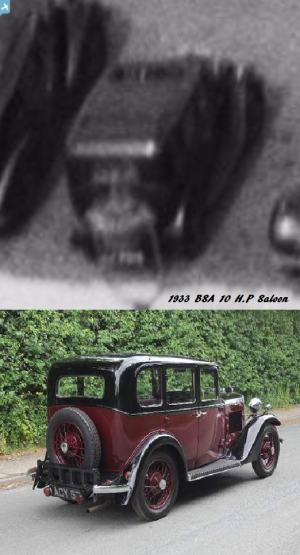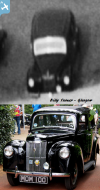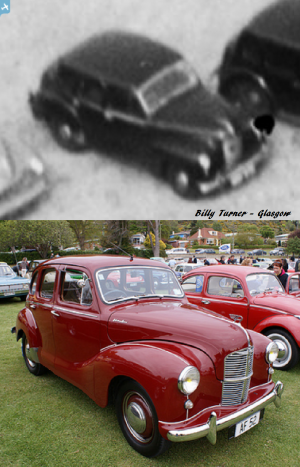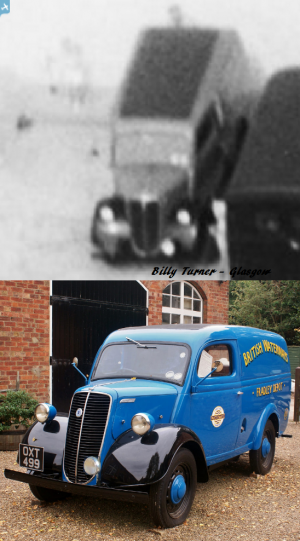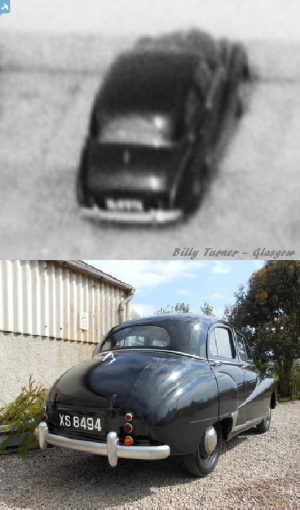 WWII Beach defence battery gun house. |

cptpies |
Friday 21st of December 2018 01:02:13 PM |
 1933 BSA 10 H.P Saloon.
The BSA Ten is a small car manufactured for BSA Cars by BSA subsidiary The Daimler Company Limited. Announced in October 1932 first deliveries were delayed until February 1933. A cheaper and less well-finished version of the Lanchester Ten with a smaller side-valve engine of BSA design. An offering to try to meet the market of the Great Depression. The motoring correspondent of The Times reported reaching 57 mph (92 km/h) under favourable conditions, the makers' estimate of fuel consumption was 35 mpg at 30 mph. The chassis with standard finish would set you back £175. |

Billy Turner |
Thursday 8th of June 2017 09:27:20 PM |
 1950–1953 Standard Vanguard Phase I Estate.
The Standard Vanguard is a car which was produced by the Standard Motor Company in Coventry, England from 1947 to 1963. It was Standard's first post-Second World War car and intended for export around the world. It was also the first model to carry the new Standard badge, which was a heavily stylised representation of the wings of a griffin. An estate car joined the range in 1950 initially for Belgium only. The body was updated in 1952 (Phase 1A) with a lowered bonnet line, a wider rear window and a new grille featuring a wide horizontal chrome bar in place of the narrow, more closely packed slats of the original grille that you see here with this car.
|

Billy Turner |
Thursday 8th of June 2017 08:45:29 PM |
 1952–54 Morris Minor Series II. Cheese grater grill type.
In 1952, the Minor line was updated with an Austin-designed 803 cc (49.0 cu in) overhead valve A-series engine, replacing the original side-valve unit. The engine had been designed for the Minor's main competition, the Austin A30, but became available as Austin and Morris were merged into the British Motor Corporation. The new engine felt stronger, though all measurements were smaller than the old. The 52 second drive to 60 mph (97 km/h) was still calm, with 63 mph (101 km/h) as the top speed. Fuel consumption also rose to 36 miles per imperial gallon (7.8 L/100 km) A horizontal slat grille was fitted from October 1954, as well as a new dashboard with a central speedometer.
269,838 examples of the Series II had been built when production ended in 1956. |

Billy Turner |
Wednesday 7th of June 2017 06:57:42 PM |
 1947–1953 MG YA sports saloon.
The MG Y-Type is an automobile produced by MG in England from 1947 to 1953. It was offered in four-door saloon and limited production open four-seat tourer versions.
When production ceased, 8,336 "Y" Types had been produced, 6,131 of which were "YA" saloons, 904 were "YT" Tourers and 1,301 were "YB" saloons. |

Billy Turner |
Wednesday 7th of June 2017 06:50:33 PM |
 1949-1951 Hillman Minx Mark IV Convertible.
In 1949 the old engine was bored out and compression ratio increased, for the Minx Mark IV, to 1265 cc, and power output increased by 7 per cent to 37.5 bhp (28.0 kW). A Mark IV tested by The Motor magazine in 1949 had a top speed of 67 mph (108 km/h) and could accelerate from 0–60 mph (97 km/h) in 39.7 seconds. A fuel consumption of 32.1 miles per imperial gallon (8.8 L/100 km; 26.7 mpg‑US) was recorded. The test car cost £505 including taxes, the price including radio (£36), over-riders (£5) and heater (£18).
|

Billy Turner |
Tuesday 23rd of May 2017 10:12:40 PM |
 1938–1948 Morris Eight Series E.
The Series E announced in October 1938 brought a major restyle with a "waterfall" dummy grille, headlights in the wings and the running boards had gone. The car was longer, wider and heavier but the wheelbase was actually 1-inch (25 mm) shorter at 7 feet 5 inches (2.26 m). There was now an 'inbuilt luggage compartment with external access' with a space available of 'close on 5¼ cubic feet with the door closed'.
120,434 were produced.
Predecessor Morris Eight series II
Successor Morris series MM |

Billy Turner |
Tuesday 23rd of May 2017 09:37:11 PM |
 1950–1953 Austin A40 Sports 2-door convertible.
The Austin A40 Sports debuted at the 1949 London Motor Show as a four-passenger, aluminium-bodied convertible version of the Austin A40 – carrying an Austin of England nameplate, bearing Austin's Flying A hood ornament, and designed and manufactured in conjunction with Jensen Motors.
Production of the A40 Sports, which was intended as a sporty touring car rather than a true sports car, began in November 1950 for model year 1951. By the time production ended in 1953, just over 4,000 examples had been produced. |

Billy Turner |
Tuesday 23rd of May 2017 09:19:24 PM |
 1938–1949 Ford Prefect E93A.
The Ford Prefect was introduced in October 1938 and built by the Ford plant in Dagenham, Essex. The original Ford Prefect was a slight reworking of the previous year's 7Y, the first Ford car designed outside of Detroit, Michigan.
41,486 were made up to 1941 and a further 158,007 between 1945 and 1948.
Predecessor Ford 7Y
Successor Ford Anglia |

Billy Turner |
Tuesday 23rd of May 2017 08:50:29 PM |
 1950's American Chrysler |

Billy Turner |
Tuesday 23rd of May 2017 08:18:54 PM |
 1947–1953 Standard Vanguard Phase 1A
The body was updated in 1952. The registration plate was moved from the rear bumper to the boot lid, a lowered bonnet line, a wider rear window and a new grille featuring a wide horizontal chrome bar in place of the narrow, more closely packed slats of the original grille. This became known as the Phase 1A.
Predecessor Standard Fourteen
Successor Triumph 2000
|

Billy Turner |
Tuesday 23rd of May 2017 07:08:26 PM |
 1949-1959 Rover 75 P4.
Announced by Managing Director Spencer Wilks on 23 September 1949 the new Rover 75, now the only Rover in production, was first displayed at the opening day of the Earls Court Motor Show on 28 September 1949. It featured unusual modern styling in stark contrast with the outdated Rover 75 (P3) it replaced. Gone were the traditional radiator, separate headlamps and external running boards. In their place were a chromium grille, recessed headlamps and a streamlined body the whole width of the chassis. A steering column-mounted gear lever was fitted.
Production
33,267 produced 1949-54
9.974 produced 1955-1959
Predecessor Rover 75 (P3)
Successor Rover 80 Rover 100 |

Billy Turner |
Tuesday 23rd of May 2017 07:01:03 PM |
 1949–1953 Ford Prefect E493A.
Post war, the Prefect design changed little until replaced in 1952. The headlamps moved into the wings and trafficators were fitted (internally lit semaphores springing out from the door pillars to signal left and right turns), though due to space restrictions these were left out on the Australian-built Ute. Only four-door saloons were available on the home market, the two-door sector being left to the Anglia but some were made for export.
192,229 were made |

Billy Turner |
Tuesday 23rd of May 2017 06:19:10 PM |
 1938–39 Ford 7Y.
Ford 7Y is a car built by Ford UK from 1938 until 1939. During that time 65,098 cars were produced.
The car was officially marketed as a Ford Eight, and was a rebodied and slightly larger version of the Ford Model Y. The car was powered by a 933 cc 8 hp Ford Sidevalve engine.
A minor facelift, unveiled in September 1939, resulted in the first Ford Anglia.
Predecessor Ford Model Y
Successor Ford Anglia |

Billy Turner |
Tuesday 23rd of May 2017 05:05:46 PM |
 1937–1940, 1946–1947 Vauxhall 10-4 H Type.
The name of the car referred to its fiscal horsepower, which at this time defined the class in which it was to compete against cars such as the Morris 10, the Standard Ten and the Ford 10. The Vauxhall 10’s advertised horsepower in 1937 was 34 bhp (25 kW).
The 10-4 was designated by Vauxhall as the H Type, with the post-war model coded HIY. |

Billy Turner |
Tuesday 23rd of May 2017 04:01:54 PM |
 1947–1954 Austin Sheerline 125.
The Austin Sheerline is a large luxury car that was produced by Austin in the United Kingdom from 1947 to 1954.
The Sheerline was designed by Austin during the Second World War, but production did not begin until 1947 because of the commitment to war production. It was a luxurious car in the style of the contemporary Rolls-Royce or Bentley but at a much lower price, around two-thirds that of the equivalent Rolls-Royce but still the price of five or six small Austins. There were about 8,000 built but it is now becoming quite rare.
Predecessor Austin 28 Ranelagh 4016cc
(announced August 1938)
Successor Austin A135 Princess
Vanden Plas Princess |

Billy Turner |
Tuesday 23rd of May 2017 12:33:53 AM |
 1948–54 Morris Oxford Series MO four-door saloon.
159,960 produced
Predecessor Morris Ten series M
Morris Twelve
Morris Fourteen
Successor Morris Oxford series II |

Billy Turner |
Tuesday 23rd of May 2017 12:18:19 AM |
 1947–52 Austin A40 Devon saloon.
The A40 Devon (and similar 2-door A40 Dorset) are automobiles that were marketed by Austin from 1947 to 1952 – the first post-war saloons to be produced by Austin – featuring a mix of old and new technologies. They were previewed by the UK press at the Paris Motor Show on 22 October 1947, who expressed immediate disappointment at the car's conservative appearance. More than 450,000 were built before the model's replacement in 1952 by the Austin A40 Somerset.
Predecessor Austin 10
Successor Austin A40 Somerset |

Billy Turner |
Tuesday 23rd of May 2017 12:11:07 AM |
 1936-1939 Austin 10 Cambridge 4 door saloon.
Compared with the preceding cars the passengers and engine were positioned much further forward, the back seat now being rather forward of the back axle. There were six side windows like the Sherborne and the quarter lights were fixed. Again like the Sherborne the forward doors opened rearwards. At the back there was now a compartment large enough to take a trunk as well as more luggage on the open compartment door when it was let down.
Predecessor none
Successor Austin A40
|

Billy Turner |
Monday 22nd of May 2017 11:57:42 PM |
 1947-1954 Austin K8 3 way van.
The K8 started in early 1946. But it soon became known as the 'Three-Way' van owing to its arrangement of double doors on both the nearside and offside, as well as at the rear, providing excellent access to the loading bay.
Predecessor Austin 10 van
Successor Austin 1000 / 1500kg
|

Billy Turner |
Monday 22nd of May 2017 11:33:32 PM |
 1939–1948 Austin 8 4-door Saloon.
The Austin 8 is a small car that was produced by Austin between 1939 and 1948.
Launched on 24 February 1939, production continued into the war until 1943. Approximately 9,000 - 9,500 of the wartime Austin models were two-seater military 8AP tourers produced for the armed services and government, and the rest were four light saloons, six light saloons, two and four seater tourers and vans. After World War II, the model was made from 1945 until 1948.
Predecessor Austin Big 7
Successor Austin A30
|

Billy Turner |
Monday 22nd of May 2017 10:32:35 PM |
 1952-1954 Austin A40 Somerset 4-door saloon.
Predecessor Austin A40 Devon/Dorset
Successor Austin A40 Cambridge |

Billy Turner |
Monday 22nd of May 2017 10:19:36 PM |
 1951–1956 Ford Zephyr Six.
The first of the Zephyr range was a lengthened version of the four-cylinder 1,508 cc (92 cu in) Consul, with a 2,262 cc (138 cu in) six-cylinder engine producing 68 bhp (51 kW). Like the Consul, the Zephyr came with a three-speed gear box, controlled by a column-mounted lever. |

Billy Turner |
Monday 22nd of May 2017 10:06:22 PM |
 1934-1935 Morris Ten Six.
|

Billy Turner |
Monday 22nd of May 2017 09:06:33 PM |
 1947–1953 Standard Vanguard Phase 1A
The body was updated in 1952. The registration plate was moved from the rear bumper to the boot lid, a lowered bonnet line, a wider rear window and a new grille featuring a wide horizontal chrome bar in place of the narrow, more closely packed slats of the original grille. This became known as the Phase 1A.
Predecessor Standard Fourteen
Successor Triumph 2000 |

Billy Turner |
Monday 22nd of May 2017 08:44:08 PM |
 1949 Humber Super Snipe Mark II.
Early Mark II Super Snipes can be distinguished by round lamps below the head lamps.The left one was a fog lamp, and the right one was a "pass" lamp with a low narrow beam for passing cars when using dipped headlights. These were dropped in 1949 in favour of rectangular side lamps which were continued in the Mark III.
Predecessor Super Snipe I
Successor Super Snipe III |

Billy Turner |
Monday 22nd of May 2017 08:15:15 PM |
 1938–1957 Fordson E83W van.
The Fordson E83W, also sold later under the Thames brand, is a 10 cwt (half ton) light commercial vehicle that was built by Ford of Britain at the Ford Dagenham assembly plant (home of Fordson tractors) between 1938 and 1957. The van was sold in Australia as the Ten-Ten, and the E83W was available in various forms around much of the world as Britain strove to export after World War II. In some countries, the 'cowl and chassis' only was imported and local bodies built.
Successor Ford Thames 400E |

Billy Turner |
Monday 22nd of May 2017 07:57:17 PM |
 1952-1954 Austin A40 Somerset 4-door saloon.
Predecessor Austin A40 Devon/Dorset
Successor Austin A40 Cambridge
|

Billy Turner |
Monday 22nd of May 2017 07:37:46 PM |
 1948–54 Morris Oxford Series MO four-door saloon.
159,960 produced
Predecessor Morris Ten series M
Morris Twelve
Morris Fourteen
Successor Morris Oxford series II |

Billy Turner |
Monday 22nd of May 2017 07:23:09 PM |































![[EAW051399] The Open Air Swimming Pool, Lytham St Anne's, 1953](http://britainfromabove.org.uk/sites/all/libraries/aerofilms-images/public/100x100/EAW/051/EAW051399.jpg)
![[EAW051400] The Open Air Swimming Pool, Lytham St Anne's, 1953](http://britainfromabove.org.uk/sites/all/libraries/aerofilms-images/public/100x100/EAW/051/EAW051400.jpg)
![[EPW038750] The Open Air Baths, Promenade Gardens and the town, St Anne's, 1932](http://britainfromabove.org.uk/sites/all/libraries/aerofilms-images/public/100x100/EPW/038/EPW038750.jpg)
![[EPW002098] The Open Air Baths, South Promenade, Lytham St Anne's, 1920](http://britainfromabove.org.uk/sites/all/libraries/aerofilms-images/public/100x100/EPW/002/EPW002098.jpg)
![[EPW002094] The South Promenade and town centre, Lytham St Anne's, from the south, 1920](http://britainfromabove.org.uk/sites/all/libraries/aerofilms-images/public/100x100/EPW/002/EPW002094.jpg)
